Posts by admin
Now For The Next Part Of The Process- Mold Making

The sculpture is divided into 8 pieces.
Once the approval is received, I then begin the next step. Even though I have spent hours painstakingly putting in all of the texture and detail, I must now cut up the sculpture. In the end there will be molds made of the following.
1. left arm
2. right arm
3. toros
4. head
5. two parts of skirt
6. left leg
7. right leg
8. base
The best part of cutting the sculpture apart is that I can work on the detail so much easier. For example, I work on the detail on the underside of the hands. This means that all though I have approval I still am spending an entire week on making parts as perfect as possible. While working on the hands, I found some chord and was able to make a better wedding ring, and give Evelyn a manicure.
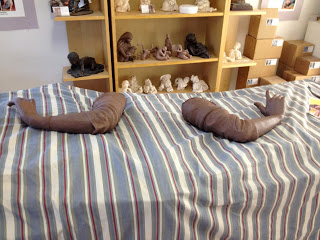
You can follow along with this entire process of creating a life size bronze for the ERJCC on the Evelyn Rubenstein project blog located at http://erjcc.blogspot.com/
The Changes That Were Made
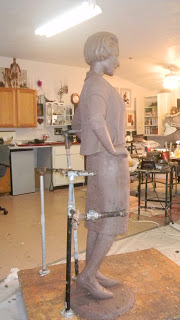
Here is the larger photograph that was provided that had so much more visual information. I separated the head from the body more time, so that I could really get close to it. Someone asked me how many times I have done this in the process? I have no idea, too many times to have kept count. The reason why I do this is that having a head in my lap is much easier than trying to sculpt while it is attached. I changed some things on the sculpture like the eyes, and tweaked the smile I also elongated her neck.
I also worked hard on the legs. I thought it important to give the sculpture a little more movement.

You can follow along with this entire process of creating a life size bronze for the ERJCC on the Evelyn Rubenstein project blog located at http://erjcc.blogspot.com/
Client Approval
I know some artists might not like client input- I LOVE IT! I really do.It is at this point when we are pushing the creative process to the very limit. I love co-create with my client. The interesting thing about this creative approval is that the client brought the photograph that you see on the right of this page, but it was a bigger version. Why would this matter? Well there was so much more visual information on the larger photograph. Good photographs cannot be overemphasized when trying to create.
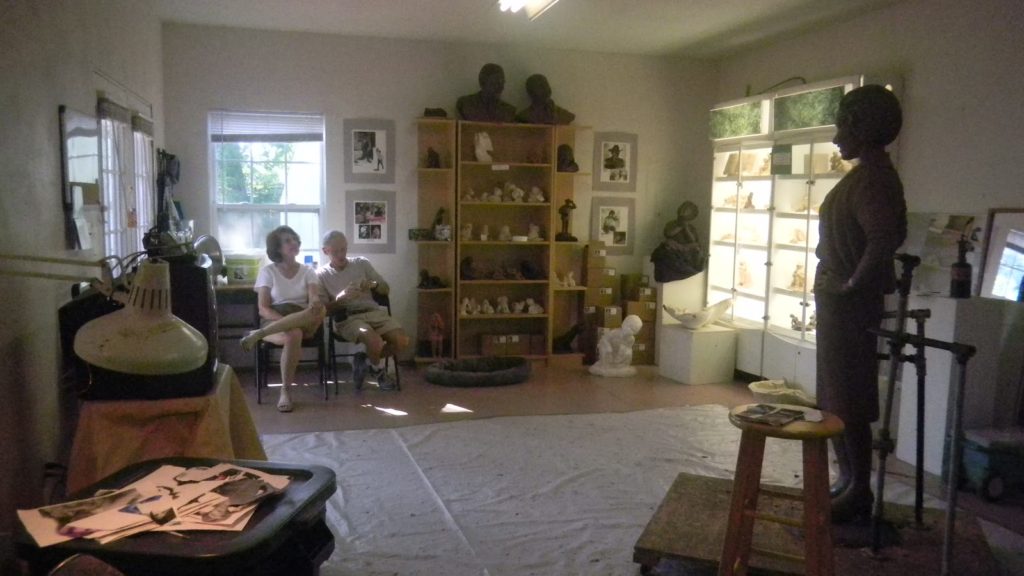
You can follow along with this entire process of creating a life size bronze for the ERJCC on the Evelyn Rubenstein project blog located at http://erjcc.blogspot.com/
Approval Of The Sculpture
I have not posted anything in the last couple of weeks and have done so on purpose. I wanted my client to come by and see the sculpture themselves. I am happy to report they are very happy with the outcome, which I will post soon. Just a bit more tweaking and then you will be able to follow the process of going through the foundry. More to come soon.
You can follow along with this entire process of creating a life size bronze for the ERJCC on the Evelyn Rubenstein project blog located at http://erjcc.blogspot.com/
Working Diligently- Thumbs Up And A Comparison Smile!
Though Evelyn is not scheduled to be delivered for quite some time, I’m working diligently to get ahead of my deadline and I am making very good progress.
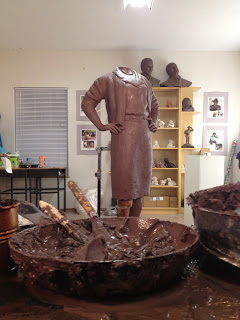
need to be done to what I have done already.
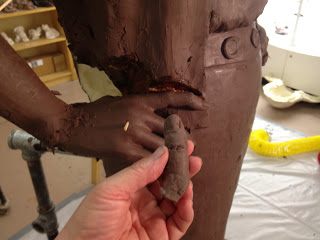
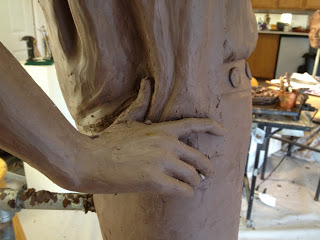
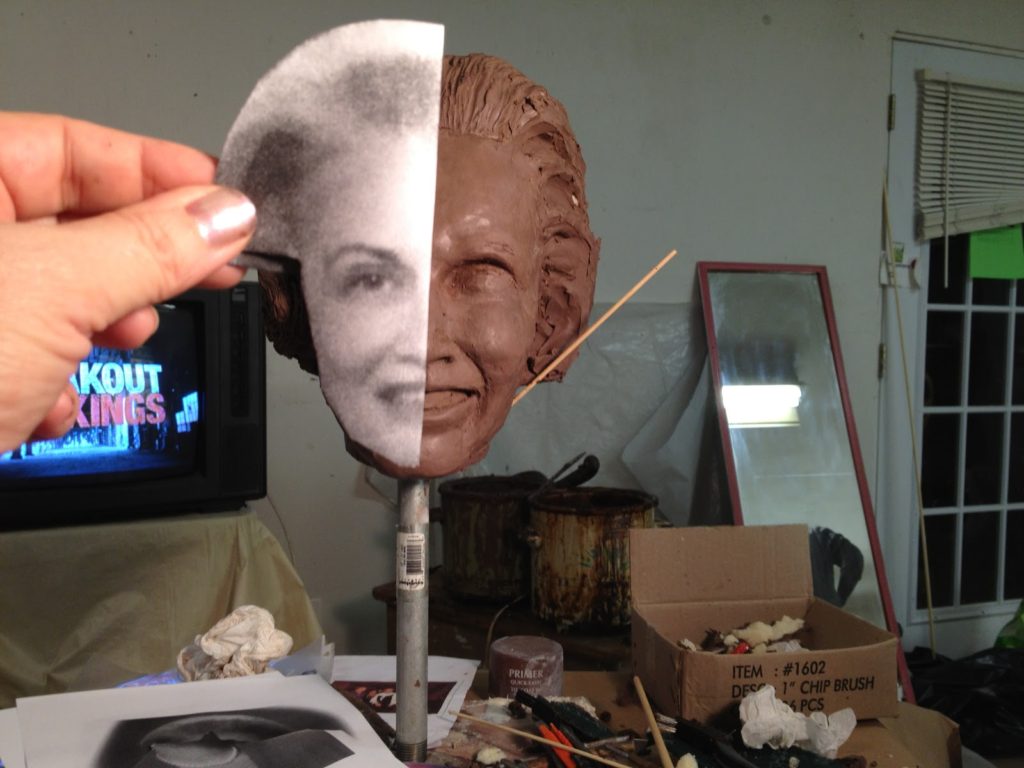
proportions in the face to those of the photograph. But doing
This from one side can be misleading.
I need to do this from the side as well. Oh, and I have to keep
putting the head on the body. There is nothing more infuriating
than to have a perfect head and perfect body that are not in
proportion to one another.
You can follow along with this entire process of creating a life size bronze for the ERJCC on the Evelyn Rubenstein project blog located at http://erjcc.blogspot.com/
Thinking About All That You Have Touched
How much does one life play against another? How has Evelyn influenced those that have been in her life? It is very interesting to think about. I sculpt her hands and think of her children’s hands that held hers, the work that she did, the things she learned. Did she like to get her hands dirty, work in the garden? How about holding the hands of her grandchildren.
I’m noticing her hands, they are as much a part of her personality as her face is. They seem strong, not necessarily slender and delicate. They remind me more of my own.
As I work on Evelyn’s hands and look at her nails I am reminded I have gone back to wearing nail polish, not as an influence of Evelyn, but due to the fact that I am working so often in the clay it is almost impossible to get all of the dark brown clay out from under my nails.
Evelyn’s shirt is complete. I like it, her waist band on her skirt is complete. I want to move to the sweater, but first I must place her hands, place them on her hips in this wonderful pose.
You can follow along with this entire process of creating a life size bronze for the ERJCC on the Evelyn Rubenstein project blog located at http://erjcc.blogspot.com/
Coming Together
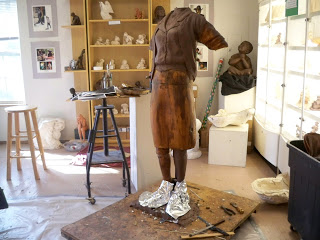
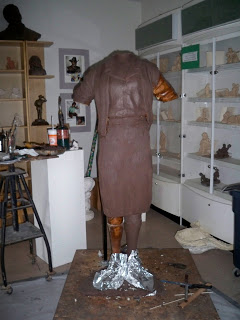
The sculpture has been coming together. I have put the legs on with my sculpted high heels. I was afraid they would get splattered with clay and foundry wax and so I have given Evelyn some tinfoil slippers. The skirt was shortened, and this means some work will need to be done with the legs, but I have decided to work from the top down. The entire sculpture is covered with foundry wax and then with clay. A former student who has come to learn mold making helps me by covering the rest of the sculpture with clay. When I see the skirt and most of the sweater covered with a thin layer of clay the sculpture becomes more intimate to me. I have only worked on the detail of the blouse adding depth and clay. The foam armature, though very helpful still needs adjusting and I often cut into it, put wax upon the foam opening and then more clay.
You can follow along with this entire process of creating a life size bronze for the ERJCC on the Evelyn Rubenstein project blog located at http://erjcc.blogspot.com/
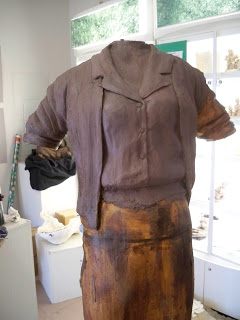
Detailed Description of The Process of Tra-digi Art
POSER, DAZ 3D and Zbrush- Creating of digital armatures
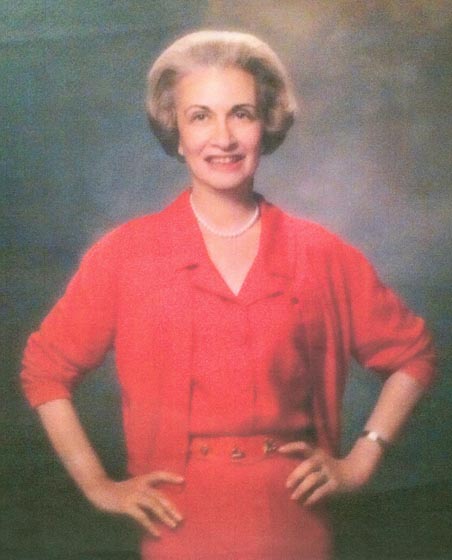
Evelyn Rubenstein Jewish Community Center.
This is a rather long and detailed explanation for a process that I use called tra-digi art. It is copied from my sculpture blog, and is intended to not only show the process, but help other individuals who are learning these processes. Tra-digi art is incorporating traditional processes with digital processes for artwork that is realized in a physical form.
In this project I’m trying to obtain an armature that I can use for the new life-size bronze sculpture of Evelyn Rubenstein. I know my pose, so I don’t need a tradition sculpted maquette to show my client. The pose is from a photograph that my client has of Evelyn in a suit. I am, however, missing some information such as the position of her legs. And I need to create a 3d model of this pose because I intend on having it milled for me. In other words, Synappsys digital services will take my 3d model enlarge it and mill it out in foam, instead of me having to go through the tedious process of welding medal, using spray foam and making a life-size armature as I used to do before the tra-digi process. This process is very similar to what I did with the 11 foot panther project.
So. using the provided picture and a program called Poser along with Daz 3d models and 3d clothes I can expedite my process by creating a similar pose to the one in the photograph.
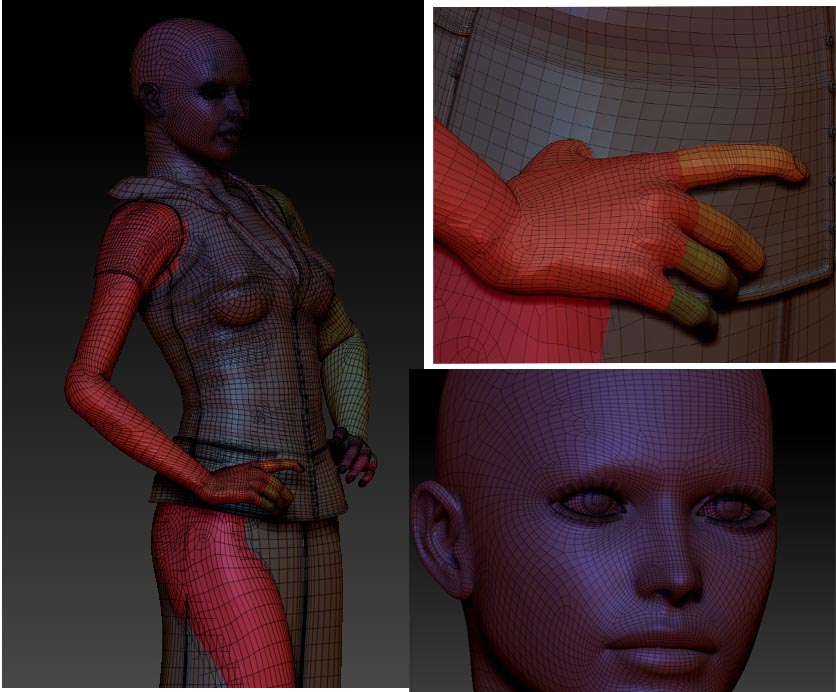
It helps me to be able to see and I can create the information that I don’t
have in the photograph, like her legs and feet
I really like working in Poser, though Daz 3d does have a free modeling program that does the same thing, I wish I had the time to learn it. Poser, feels very intuitive for what I am trying to do, I can push and pull, repose, try different things- meanwhile seeing my figure from all sides and getting to “feel” the pose. I’m not using Poser to “create my art,” instead it is just as one would use their clay, or how we used to use an old wooden maquette to get a feel for the pose and try out different elements. I have done this before and have a video of the Jenna project that shows this process in more detail.
In the picture of the Poser model on this page, it is showing the mesh, or underlying structure. I need to see this to be able to know how things will work as I continue on the sculpture. For example, this model has eyelashes. I would not want that “milled” out and so they must be taken out before I can bring it into zbrush.
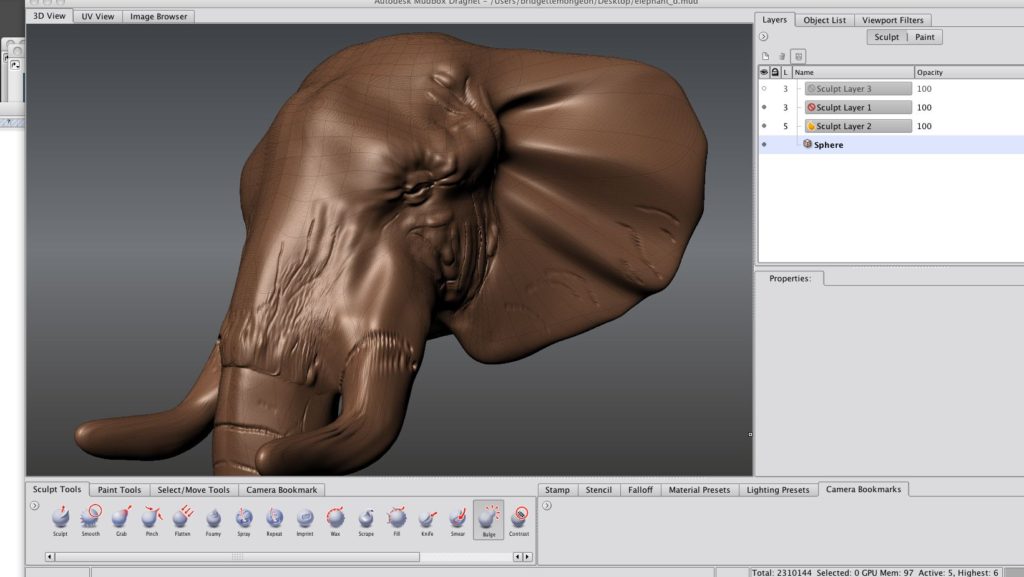
the underlying mesh or geometry. Then when you tried to sculpt
on the piece it would be deformed.
Zbrush by Pixologic, is one of the digital sculpting program that I use. It has quite a few new features. Dyanmesh being one of them. Usually Dyanmesh is used to sculpt from a blob, pull things out and then it remeshes the 3d model so there is no pulled or deformed geometry. This pulled gemoetry was one of the things I hated about digital sculpting, when I started years ago. Basically what this means is that behind every computer generated sculpture there is an underlying mesh.
If you double click on the elephant sculpture you will see a larger photograph that demonstrates the pulled mesh that I am speaking of. See how the squares are not uniform but some are bigger and further apart? Now, the digital tools are improving. It makes it more and more like traditional sculpture. For example, with Dyanmesh in Zbrush- just pull and push and add digital clay and then press a Dyanmesh button and the program magically creates your sculpture into an overall good workable mesh.

So far my workflow has been, Poser, and Zbrush, but I have had to do this in parts. When bringing the entire figure back into Poser I am using Dyanmesh to remesh the underlying structure so that I can revise it.
I had to experiment with a few different resolution settings. But I was able to get a pretty good mesh that I could work on. Problems with dynamesh with my process- holes. I found that I had some holes in the geometry in my piece when I remeshed using dynamesh in Zbrush. Just use the inflate tool and then remesh using dynamesh and this usually fixes the problem. Remember you are trying to get a basic geometry to work with. You can’t do details when using dynamesh.
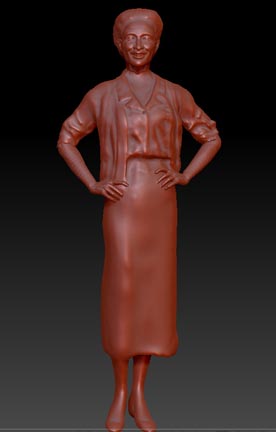
Still needs some work.
I believe I will shorten her legs
a bit as well as her skirt.
I also will add her pearls.
The back of the sculpture
needs work, I’m off next
week to take some pictures
of her daughter-in-law
with a sweater on
so I can see the folds.
Yes, I could have started from scratch and sculpted Evelyn in the computer from a ball of clay, but this way expedites my process. I can see what a mesh will look like coming from Poser and remeshed. I think this may work.
I worked on the head, which in this view still needs more hair and is not a true likeness of Evelyn, but has a good form to start with. Much of the final detail is done in real clay down in my sculpture studio. I also worked on her arms separately. Now that I have gotten her this far here are the problems I have to work out.
Height. I believe my original model used in Poser is too big, and after confirmation I find that the Victoria 4 base model is 5’10.5″ tall. My subject evelyn is 5’6″. This confirms some of the visual things I was noticing with this sculpture. The other thing is that I believe the skirt in this view is a bit too long. Call me a stickler but I’m going to shorten it a bit, or try different lengths to see what I like. Back to the drawing board. I’ll update more later.
If you are new to 3d sculpting and want to learn about topology, a wonderful video is created by Guerilla CG Called Subdivision Topology: Artifacts. It is a good thing to realize what is going on behind the scene, but I am thankful that the sculpting programs are making it easier for artists to sculpt without having to deal with the mundane but necessary topology.
Armature-Part 2
I have been using digital processes with my traditional sculpting processes for a while. A process I call tra-digi art. I was thrilled to create a book on part of this topic called Digital Sculpting In Mudbox: Essential Tools and Techniques for Artists.
It still feels strange to do so much work on a sculpture and not getting my fingers dirty in clay. But here I sit in my office, above my studio, working out details of Evelyn. The pose has been decided on, but there are some details of this pose that need to be worked out.
1. In what position are her feet? What is the missing information that I don’t have in my reference photograph?
2. How will she stand within her placement at the Evelyn Rubenstein Jewish Community Center? She is going in the lobby, but we need her to work well in the lobby design and, still be secure. That means she has to be secured to the floor and perhaps a third point. I’m considering hiding that 3rd place of securing in her right elbow sweater folds.
I will not be creating this armature in the traditional process as mentioned in part one, instead I will be creating the basic armature of her within the computer and Synappsys Digital Service In Oklahoma will take my 3d file and then mill out an armature in foam. Then, I will cover the foam with clay and add my details. You can see this milling part of the process in the video showing Jenna in the previous post. You can also see how we used a foam armature if you take a look at the Prairie View Panther Project Blog. The Prairie View Panther was a large 11 foot panther that was created in bronze for Prairie View University in Prairie View Texas.
In the next post you will see my process of working up the digital sketch of Evelyn for her armature.
Creating an Armature- Part 1
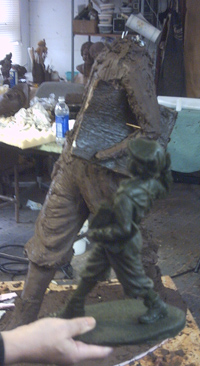
to the enlarged Newsboy sculpture
piece, point by point. This will
not be the process used to
create the armature of Evelyn.
Instead new digital process
will be used by the artist.
Traditional sculpture has changed for some over the years. When it comes to creating a sculpture for a client, many start with a small maquette, or small sculpture. This is usually done to try to obtain a pose and work out the movement of a piece. An example of creating a maquette can be seen in my Newsboy blog, and is shown on this page.
In the case of the Evelyn sculpture we are not going to create a maquette. Instead, we are going right to a large sculpture. The reason for this is that we know the pose. It has been decided on, and there is little to figure out in this sculpture project.

life-size sculpture
of the newsboy.
Going from a maquette to a large sculpture in the traditional process can be very, very time consuming, and up until adding digital technology to my process, it was one of my least favorite things to do. There is some detail about this traditional process in my journal of creating the newsboy. The process consists of measuring up the sculpture, point by point, creating an armature, made up of rebar, and or pipe, chicken wire, spray foam and then of course clay. It is time consuming and not a very creative part of the process, but it is necessary.
New part of my creative process
Over the last few years I have been incorporating both traditional process of sculpting with digital technology. You will see this in the up and coming posts about the armature. I call this tra-digi art. I love it, it expedites my process, gives me more control over my tools, and when these tools are used to help to create a pose, as the example of Jenna in the video below, it helps my client to visualize the piece.
Here is a video that describes how I have used tra-digi art in the past. Check back to see how we are using this with Evelyn.

